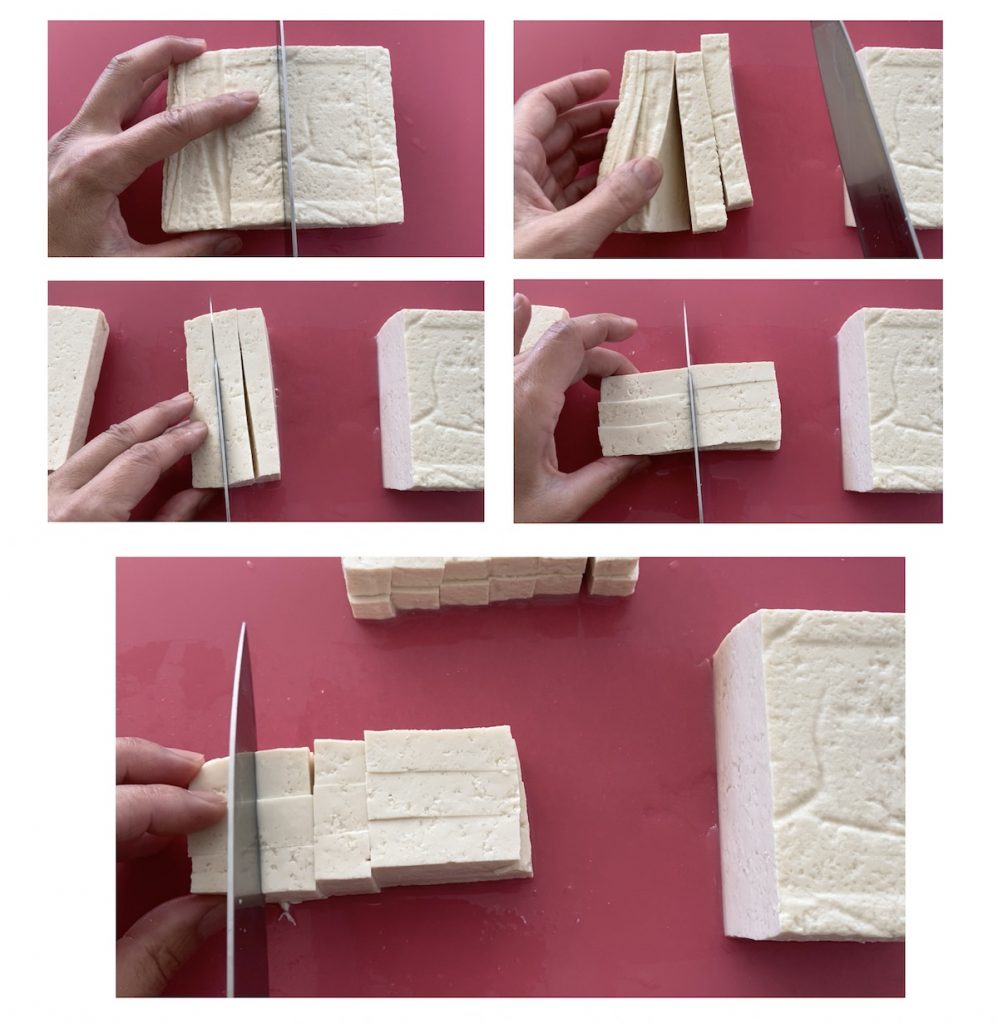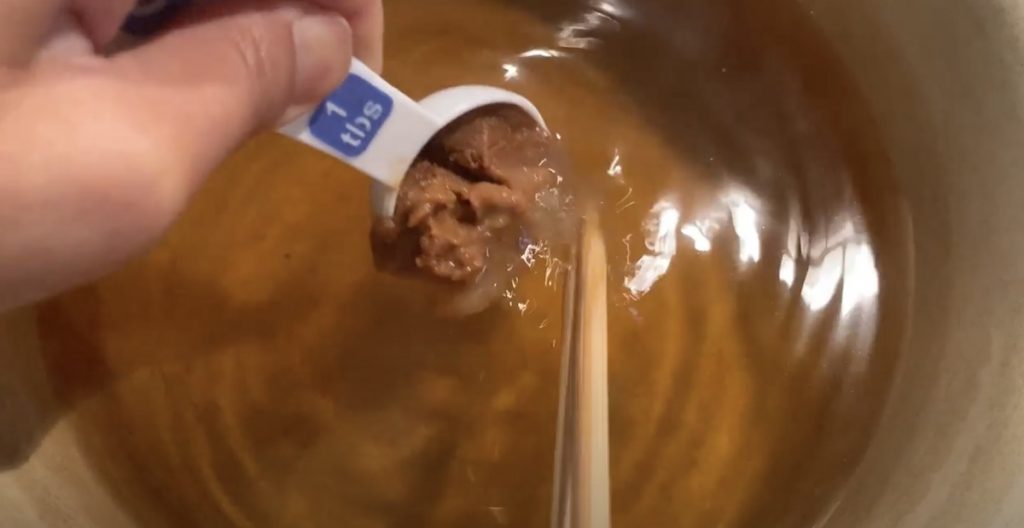Today’s video covers miso soup but with a twist! Instead of tofu and green onions which is the traditional style, I show a country style of miso soup with potatoes and yellow onions. My mom made this for us growing up! Miso soup is a great dish to prepare throughout the year. And, when served with sushi and sunomono (from my earlier videos!), you have a complete meal! (Not including dessert, but we will cover that next week.)
Miso soup may seem a bit complicated because of the ingredients, but don’t panic. It’s actually quite simple. I will cover the basics below.
QUICK DEFINITIONS:
- Katsuo = dried bonito (A type of fish)
- Kombu = long strips of dried kelp
- Wakame = cut and dried seaweed
- Dashi = soup stock (Can be made of any combination of powdered fish, dried fish packets, powdered kombu, and/or kombu strips. I use katsuo as my powdered/dried fish of choice.)
List of Ingredients for Country Style Miso Soup
For Traditional Style Miso Soup see below.
-
1 Pouch of Dried Katsuo — Katsuo, also know as dried bonito, is a type of fish used in my stock today. This can come in packets of dried powder or pouches of dried fish. I prefer the pouches of fish because I feel the stock has a richer flavor but I have used both with success. And if you use the powder version, just make a mental note if there is salt added or not so you can adjust accordingly. Since not all powdered packets are the same, follow the directions on the packaging for 5 cups of water. Also, note that it’s very easy to add more powder so it is fine to undershoot the measurements initially.

Katsuo packaging There are several kits for dashi soup stock available on Amazon that include the dried powder or fish.
- 2-3 pcs Kombu (approximately 5 in. long) — Kombu is a type of dried kelp used to form the dashi (i.e., stock). You can get kombu at any Asian market or on Amazon
. You will notice a white powder on the kombu/kelp but that is totally normal. No need to worry, use as is! Look for kombu from Japan but any brand works.

Kombu packaging - 2 Tbs. (I use slightly heaping measurements) of both Red and White Miso — Miso can be confusing because there are so many to choose from. I use Cold Mountain, red and mellow white. These have great flavor and better yet you can usually find this brand at the local grocery store. I have seen Cold Mountain at Safeway and Whole Foods. The blend of red and white miso makes for a nice flavor, but you can easily use just one or the other. I would say purchase what is easiest and experiment. Amazon also sells red miso paste and white miso paste
.
- 2 Medium Russet Potatoes (About 2 cups cubed) — Red potatoes work well, too. And better yet, if you use red potatoes you don’t need to peel them!
- 1 Yellow Onion (small is okay!) — Only a small amount is used!
- ⅛ Cup Wakame (Cut and dried Wakame/Seaweed) — Wakame is a type of seaweed sold in cut and dried form in packages, such as this one on Amazon
. Some packages have freeze dried tofu and green onions (or other extras) along with the wakame! For today’s soup, I kept it simple with the basic wakame without extras.

Wakame packaging - 5 cups water — You may need more to add after simmering the stock or to adjust the flavor.
For Traditional Style Miso Soup
Use Tofu and Green Onions Instead of Potato and Yellow Onions
-
½ Block of Tofu (instead of potato) — Tofu comes in different softness. There is the silken or very soft tofu to extra firm. I typically use firm tofu because it is easier to purchase but use whatever texture you enjoy. Probably best to stay away from the extra firm, though.
Cutting the Tofu: Rinse the top of the tofu container and slice open to drain out the water. Now take the block out of the container and place it on the cutting board. Cut the block in half. Set aside the portion not being used.
When cutting into cubes for miso soup, I take half a block of tofu and cut lengthwise into 4 slices. I then lay those down two at a time and cut into 3 long strips again working lengthwise. Now turn the strips and cut into half. Those halves will be cut into 3. Now you have cubes. Repeat with the other remaining 2 slices. (Add tofu when instructions call for potatoes.)Preserving Extra Tofu: Take the unused block and place in a container that has a tight fitting lid. Fill the container with water (ideally filtered) until the tofu is fully submerged. Cover with the lid and place in the refrigerator. This will keep nicely for future use. Try to use it within a week.

- 2 or 3 stems of Green Onions (instead of yellow onion) — Chop the green onions. (Add green onions when instructions call for the yellow onions.)
Preserving Extra Green Onions: If you find you have chopped too much green onion, place the extra as a thin layer in a Ziploc bag and place inside your freezer. This keeps nicely with a decent flavor until the next time you make some more soup! And when frozen as a layer, you can break off what you need easily.
List of Tools
- 3 quart pot
- Ladle and resting plate
- 1 Tablespoon measuring spoon
- ⅛ cup measuring cup
- Chopsticks (The chopsticks are not necessary but helpful, you’ll see why later!)
- Vegetable peeler
- Knife and cutting board
- 2 cup measuring cup (Just to loosely measure the quantity of cubed potatoes)
- Small serving bowl (I use a rice bowl. I have to admit that I don’t even own any traditional miso soup bowls!)
Making the Dashi (i.e., Stock)
Okay, now let’s get the dashi (i.e., stock) started. While it’s simmering, we will prepare the other ingredients….and then the dashi will be done!
- Add the 5 cups of water to your 3 quart pot.
- Add 1 katsuo pouch and 2-3 pieces of kombu. This is a popular method for making the dashi. (But don’t be afraid to make this according to your preferences whether that means kombu only, fish only, powdered fish, powdered kombu, etc…)
- Then, bring the pot to a boil and immediately drop to a simmer, making sure that everything is submerged. Cover your pot, leaving the lid slightly ajar. Let that continue to simmer and check once in a while.
Prepare the Potatoes and Yellow Onion
(Tofu and green onions covered above)
- Peel the yellow onion and set aside.
- If using russets, please peel. But if using red potatoes, go ahead and leave the peel on!
- Very thinly slice the yellow onion. I use just a tiny bit. You can easily add more if necessary.
- Cut the potato into ½ inch cubes. You really want the cubes to be about the same size so they cook evenly together.
Back to the Dashi (i.e., Stock)
Now our dashi should be done! (It should simmer for about 15 minutes.) Remove the kombu and the pouch using chopsticks or tongs. You can dispose of the katsuo pouch and kombu. As you can see, the water level dropped dramatically. Just add back enough water to around the starting level.
Let’s add our miso! This is where the measuring spoon and the chopsticks come in. You will be using two heaping tablespoons of both red and white miso. When you do this, take your chopsticks to break apart the miso as it enters the stock from your tablespoon. This is to avoid a big blob of miso sitting at the bottom of your pot.

Now, we can add in about 2 cups of potato (or ½ block of cubed tofu). I then added about ⅛ cup of wakame. (add more if you would like, just be careful since it’ll expand!) Add the onions (or chopped green onions) and start up the stove to bring the soup to a boil. Boil for between 30-60 seconds and then turn off the stove, cover and leave on the burner. The potatoes will be cooked after 30 minutes and your soup is ready! (If using tofu, your soup is ready immediately!)
And FYI, miso soup is very forgiving. At this point, try a little, and, if the flavor is weak, add some more miso. Or if the flavor is too strong, add some water. And that’s it! And when you are ready to eat, just reheat!
By the way, my family loves to eat miso soup with Tabasco! Definitely give it a try!
Hope you enjoy!
As an Amazon Associate I earn from qualifying purchases.

